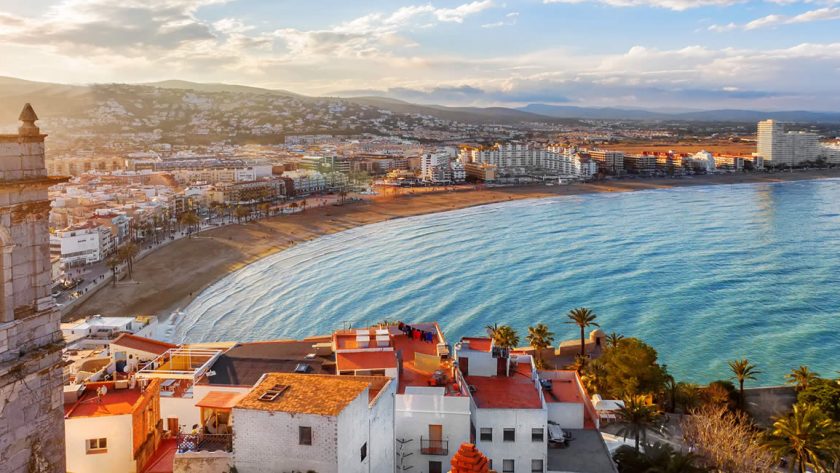Learning Spanish in Spain hardly feels like going to school. An average day might start with an expertly brewed café con leche and end with a delicious dinner of light tapas and endless glasses of local Rioja wine. The in-between hours are probably peppered with long strolls through winding cobblestoned streets and hours spent sketching Moorish architecture while listening to the passionate wails and intricate guitar licks of local Flamenco artists. Students will spend a couple hours in the classroom each day, but the real learning takes place on the streets, at the beach, in the markets, and in the bars and clubs. This is where the classroom meets the real world, and where flirting with that local cutie is actually a real-life lesson in conversational Spanish. This is full-on, sink-or-swim language learning but don’t worry – the instructors are there to make sure everyone stays afloat.
The secret to learning a language is to fully immerse yourself in the culture, as well as the language. You need to take the classes, but you also need to listen to the music, read the local news, shop in the markets, and shake hands with the locals. These Spanish language school programs are designed to help the students connect with the culture, usually while getting college credit. And you can be sure that these programs are wildly different from any language courses that you may have taken in high school or at your university. The main focus is immersion learning, so the instructors usually speak exclusively in Spanish from day-one, and encouraged students to get out of the classroom and experience the language firsthand. They know that the only real way to learn a language is to live that language, so they use techniques that force you to learn on-the-fly.
This summer I accepted a two-week trip to Spain courtesy of the Tourism Office of Spain to visit some of these Spanish language schools first hand. I visited multiple schools in the Valencia and Andalucia regions, where I was able to talk with students, participate in lessons, and get a real feel for how the whole process works. All of the schools I visited were members of FEDELE (The Spanish Federation of Associations of Spanish Schools for Foreigners – www.fedele.org ), an association that helps to take some of the guesswork out of finding a good school that fits your learning style. The folks at FEDELE make sure that all the schools in their federation are Cervantes accredited, meaning they have passed a series of tests, guaranteeing that all of their facilities, teachers, and programs are of a certain caliber. All FEDELE schools themselves are very different along with the cities they are located in, so you’ll still have to do some research to find the school that fits you best. The prices are not standardized – you can expect to pay anywhere from $300 for a two-week intensive course, to over $2500 for a 12-week course at one of the flashier schools. In essence the programs are very similar because they have all received the Cervantes and FEDELE stamps of approval. This way, you know you’ll be getting a quality education from teachers who are up to the task of teaching Spanish to a mono-lingual American.
Laughter in Every Classroom
The teachers at these language schools are all incredible at using their expressions and gestures to make you understand what they are saying in a fun and engaging way. Bob Burger, Marketing Director of the Malaca Instituto language school in Malaga, has referred to some of the teachers at his school as, “off-the-wall extroverts,” and notes that usually, you can hear laughter coming from every classroom. These zany and engaging language teachers aren’t limited to the Malaca Intituto – you can find them in classrooms all over Spain, and they all seem to have a magical way of making language-learning fun.
Sometimes it can feel like you’re watching a one-man comedy show, but as you begin to understand and participate, you also begin to communicate and to learn. It’s a very natural process, and it really works. After just a few months at a language school, Maya Wodnicka, of Texas said, “Now, my daily contact is with people who 5 months ago, I didn’t even understand!” And that’s the key – these teachers give you the linguistic tools to take your leaning outside of the classroom and interact with locals every day. You’ll be surprised how quickly you pick up everyday phrases and conversational quips! Jana Eichmann, a student from Paderborn Germany said, “I never thought I would learn to speak Spanish so quickly! Of course, I’m not perfect after 4 weeks, but now I can communicate with the local people!”
Getting Credit
Most of the FEDELE schools have agreements with American universities to allow for easy credit transfers. You’ll always want to check with your university to make sure that you’ll get credit before you finalize your plans. Some schools will require you to arrange the specifics of the credit-transfer through your university’s registrar. Often, there will be an agreement in place with one or two US universities, so you transfer the credit from them, instead of from overseas, which makes the process significantly easier. Besides Spanish language classes, some schools offer classes in Spanish politics, history, flamenco, and cooking — sometimes just for fun and enrichment, and sometimes through local universities for transferable credit.
Some students want to take Spanish classes just for fun – it’s a great excuse to go to Spain and sample the local Sangria! Even if you’ve already completed your language requirements, or if you’re about to graduate, you’ll be in good company. Many of the students you’ll meet are recent grads, looking for a way to enhance their resumes with language skills and international work experience. Anita Kover, a student at the Don Quixote language school in Valencia is a recent graduate from Corvinus University of Budapest in Hungary. She has a degree in economy, but wanted to add Spanish to her already impressive arsenal of languages (she speaks Hungarian, French, and English already!) to help boost her resume. She chose to study at Don Quijote because of a special program that combines one month of Spanish language classes with a two-month placement in a hotel or restaurant job in Spain. “I couldn’t afford a three month program,” she said, “but this way I can study for one month, and then continue my studies by working.” Many of the language schools in Spain offer similar programs, some for students looking for credit, and others for those just looking to learn the language.
Where to go?
Even once you’ve made the decision to learn Spanish, you have to decide where to go to learn it. There are no less than 21 countries that list Spanish as an official language, so you’ve definitely got options – from Argentina to Venezuela. Spain has become a popular choice for American students, interested in learning Spanish abroad. The great weather, laid-back culture, and amazing history of Spain are major draws for international students – as well as the fact that all of Europe is right in your back yard! A weekend in Paris, London, or Berlin is just a short flight or train ride away, and many students like to schedule in a month or two of European backpacking either before or after their language courses in Spain.
But Spain is a large country with many unique regions and cities – so deciding where in Spain to study becomes the next step.
Andalucia Region
The Andalucía region is a very popular destination for students of Spanish, with 35 Fedele schools spread along the sunny coastline and inland from Seville and Granada. One popular Andalucian destination for language-learners and travelers alike is Seville. It has plenty of excellent schools to choose from, and a large and welcoming student population. There is something special about the city, from the towering grandeur of El Cathedral, the largest gothic cathedral in the world, to the narrow, labyrinthine network of alleyways and the expansive plazas where locals and tourists enjoy cold cervesas and brimming glasses of wine late into the evening. Some say it’s the weather. Others say it’s the light (Seville gets more than 3,000 hours of sunshine each year!). But whatever it is, the city certainly has an enchanting charm. In the words of Nicholas Guidera, Executive Director of FEDELE school, The Center for Cross-Cultural Study, “Seville doesn’t leave anybody unchanged.”
Malaga, on the southern coast of the Andalucia region is another sunny destination that draws language-learners from around the world to its sandy shores. This beautiful city is a hot-spot for language schools, probably because students can enjoy days at the beach, tanning and snacking on espeto de sardinas, a local favorite that consists of skewered and fire-roasted sardines. Some even visit Africa on the weekends, because from Malaga, you’re only about 2 hours from Morocco! The coastal gem of Cadiz is also nearby, with its rich history, beautiful vistas, and sandy, resort-worthy beaches. There are a few FEDELE schools in Cadiz as well as the neighboring towns of Jerez de la Frontera and Conil de la Frontera.
Granada is home to The Universidad de Granada, which has a city-wide campus with over 80,000 are students, giving the entire city a very young and hip vibe. Granada even has a language school built partially inside of a cave in the hills. Many of the other schools are located at the top of steep cobblestoned streets, with spectacular views of the sprawling Alhambra — Spain’s most visited monument. This city has a little bit of everything, including a nearby tropical coastline and mountains you can ski or snowboard on, both less than an hour from the city center. The bars in Granada are the only ones in Spain that offer free tapas, so you can get your booze on while snacking your way to a free dinner. And the music scene is possibly the best in Spain, drawing comparisons to Seattle for its high concentration of hip, indie, up-and-comers.
Valencia Region
Following the coast north from Andalucía, along the Mediterranean, you’ll come to the region of Valencia, home to cities 15 FEDELE-approved schools spread across cities like Alicante, Denia, Castellon, and of course, the city of Valencia herself. Castellon is a picturesque city on the Costa del Azahar of the Mediterranean Sea. The city has a quaint local feel, and most students feel at home here after only a few weeks in a language school. One nice perk is that the city offers free bicycles for use all over the town. You can pick one up at one of the many stands located around the city, use it to run errands, visit your new friends, or head to the beach, just a cruisy 25 minute ride from the city center.
The coastal city of Alicante has three FEDELE language schools for students to choose from. With over 300,000 residents, Alicante is not a small city, but it does manage to maintain the feel of a friendly town, with walkable streets, friendly shopkeepers, and welcomcing bars and cafes in the expansive plazas. There is an old fortification on the hill where the city was founded, and a short hike to the top will reward you with 360 degree views of the golden brown hills and the luscious blue Mediterranean. Many students come here are looking for a combination vacation and language course, because of the sandy beaches and relaxed, holiday vibe of the city. About an hour up the coast, you’ll find Denia, a much smaller city than Alicante, with only about 50,000 residents. Denia offers a similarly cruisy vibe, with beaches and bars full of relaxed vacationers. There is one excellent FEDELE language school in Denia for students who want avoid the hustle of a big city, and enjoy the slow life with the locals.
Valencia is the biggest city in the region, with a population that is edging towards one million. The city is commonly used by travelers as a gateway to the island of Ibiza, where electronic music throbs 24/7 and the clubs are always packed with sexy, young revelers, dancing the night away! But that’s not all Valencia has to offer – check out the stunning architecture of the Ciutat de les Arts i les Ciències, designed by superstar Valencian architect Santiago Calatrava. The complex features an interactive science museum, an Imax theater, an opera house, and various other buildings, all designed with impossible lines and gravity-defying shapes. Valencia is also the birthplace of Paella, a traditional (and delicious!) rice dish, often made with large shrimp, rabbit, chicken, and various other morsels, all cooked in a giant Paella pan, and traditionally served family style. Most of the language schools in the Valencia region will offer Paella cooking classes, so you can learn the names of the different ingredients and cooking utensils, while learning to cook and enjoying a delicious meal with your classmates and friends.
The rest of Spain also has many Cervantes accredited language schools to choose from, with 10 schools in Madrid, 13 schools in the region of Castilla y León (mostly in Salamanca), 5 schools in Barcelona, 2 in Basque Country, 2 in the Canary Islands, and finally one in Santiago de Compostela. While I didn’t get to visit all of these regions during my short, two-week stay in Spain, I do know that each city has something special to offer any traveler or language school student. The friendly and fiesta-prone locals, the buzzing nightlife, the stunning architecture and art, and the epic history of Spain are certainly not limited to Andalucía and Valencia – you’ll find something amazing around every corner!
Where to Stay?
Many language schools offer convenient, on-site accommodations for their students. These can range from premium private suites to no frills dorm-style rooms. On-site accommodation means that you’ll be conveniently close to your classes – but it also means that you’ll be close to the other students who you’ll have fun practicing your Spanish with, and probably enjoying a couple afternoon Sangrias with too!
Most schools also offer off-site housing for their more independent students where you’ll usually share an apartment with other international students, some staying for just a few weeks, others for a full year.The best option is to do a Home-Stay with a host family. You’ll be matched with a local Spanish family, usually you’ll have your own room, and some or all meals are included. When you stay with a host family, you get much more than a bed to sleep in and a home-cooked meal – you get real-life Spanish-speaking practice, and non-stop cultural exchange! You’ll learn to speak Spanish quickly when you realize that won’t get that second helping of delicious paella unless you remember how to say “¿puedo tener una segunda ración de paella, por favor?”
The People and the Parties
No matter where you decide to study, you’re sure to meet some fun and interesting people while practicing your newly acquired Spanish language skills. You’ll be rubbing elbows with a great group of international students, but you’ll also be meeting locals everywhere you go, and certainly making some new friends along the way. Spaniards are generally friendly folks, and the love to live life to the fullest – you can often find plazas packed with jovial locals, every night of the week. All the language schools know that a big part of learning a language is learning the culture – and a big part of Spanish culture is the love of the fiesta! These schools expect you to go out and meet locals and join them for drinks, dinners, or lively sessions of passing a bottle amongst new friends in one of the many plazas.
Some of the schools even schedule your classes in the afternoon to make sure you have adequate time to recover from those stiff Spanish cocktails and late-night dance sessions with your new Spanish friends. Building a social network is a great way to find opportunities to practice your Spanish, and if you put yourself out there, you’ll quickly become a part of the local community. Any traveler worth his weight in Let’s Go guidebooks (and overused metaphors) will tell you that the most important part of any adventure is the journey, not the destination. But if you ask a student in a Spanish language school, they’re more likely to tell you that the most important part of their adventure was the community that they became a part of.
|
Reasons to Study Spanish in Spain
What you tell your parents vs What you’re really thinking |
||||||
|



